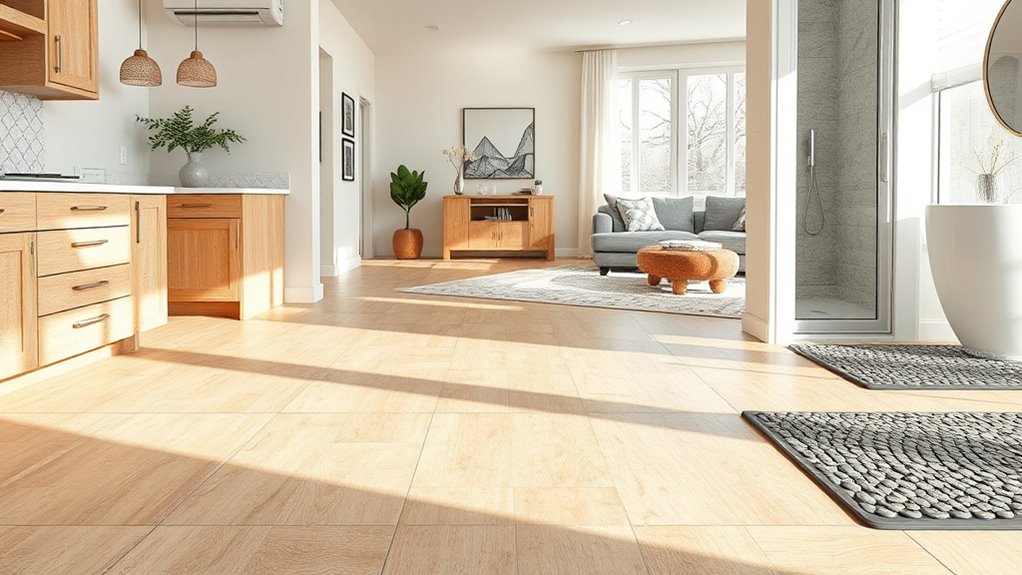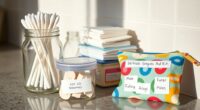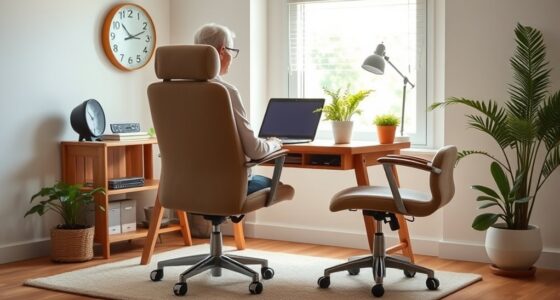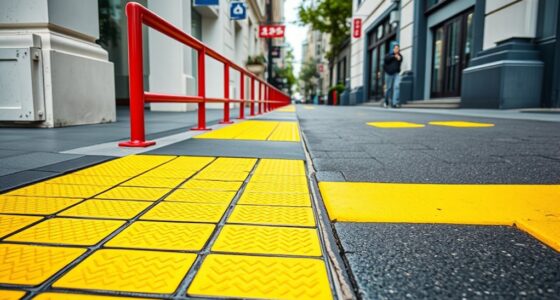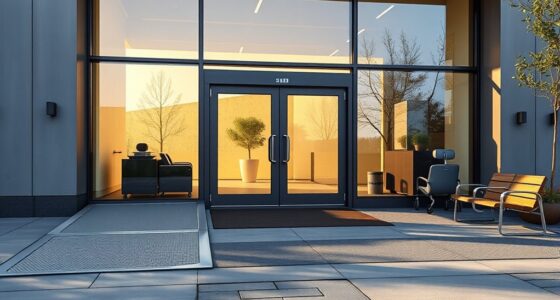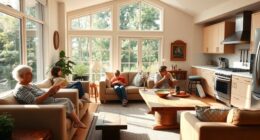When choosing non-slip flooring, select textured materials like ceramic tiles, textured vinyl, or stamped concrete for bathrooms, wet areas, and outdoor spaces to prevent slips. In kitchens and high-traffic zones, opt for durable, slip-resistant surfaces such as epoxy or treated carpets. Living rooms and hallways benefit from textured vinyl or laminate that resist wear. Proper maintenance and cleaning are essential to keep surfaces safe. Keep exploring different options to find the best solutions for every room.
Key Takeaways
- Choose textured, slip-resistant materials like ceramic tiles, vinyl, or textured pavers suited for each room’s environment.
- Prioritize moisture-resistant surfaces such as vinyl or stamped concrete for bathrooms and outdoor spaces.
- Use slip-resistant coatings or sealants on smooth flooring to enhance safety in high-traffic and wet areas.
- Select durable, impact-resistant materials like high-quality laminate or hardwood for living areas and hallways.
- Incorporate layered safety features, such as anti-slip rugs and mats, to improve traction without compromising style.
Non-Slip Flooring for Bathrooms and Wet Areas
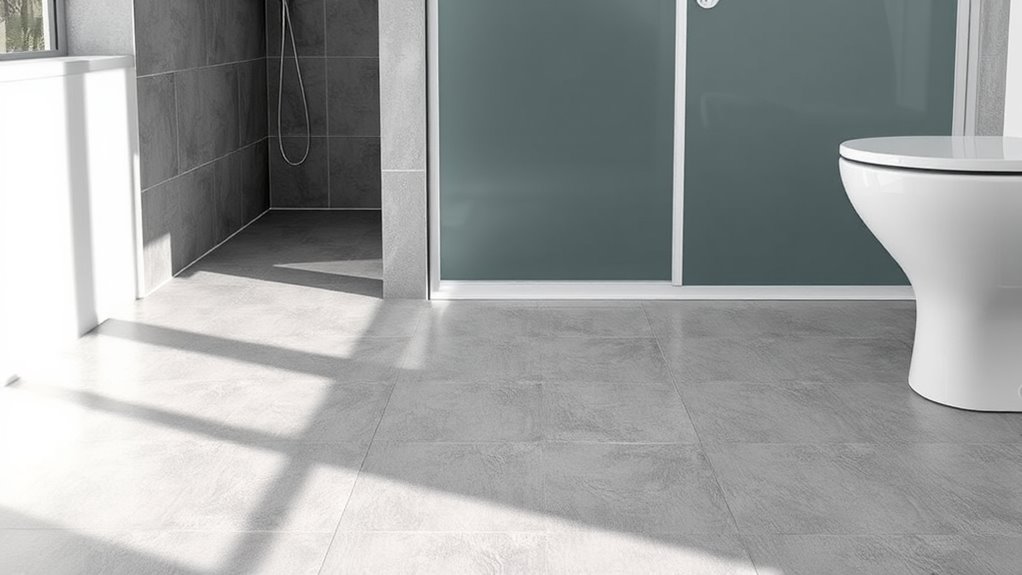
When choosing flooring for bathrooms and wet areas, safety should be your top priority. Slip-resistant coatings are essential to prevent accidents on wet surfaces. Look for flooring with textured finishes, as they provide better grip and reduce slipping risks. These finishes create friction underfoot, making them ideal for damp environments. Many materials, like ceramic tiles or vinyl, can be treated with slip-resistant coatings or specially designed textures. Regularly maintaining these surfaces is also key, as dirt and soap scum can diminish their effectiveness. Using proper maintenance techniques helps preserve slip resistance and prolongs the lifespan of the flooring. Additionally, selecting flooring with tested slip resistance ensures you choose options that meet safety standards. Incorporating slip-resistant flooring standards into your selection process can further enhance safety. This proactive approach minimizes falls and boosts confidence when moving around in wet conditions.
Safe Flooring Options for Kitchen Spaces
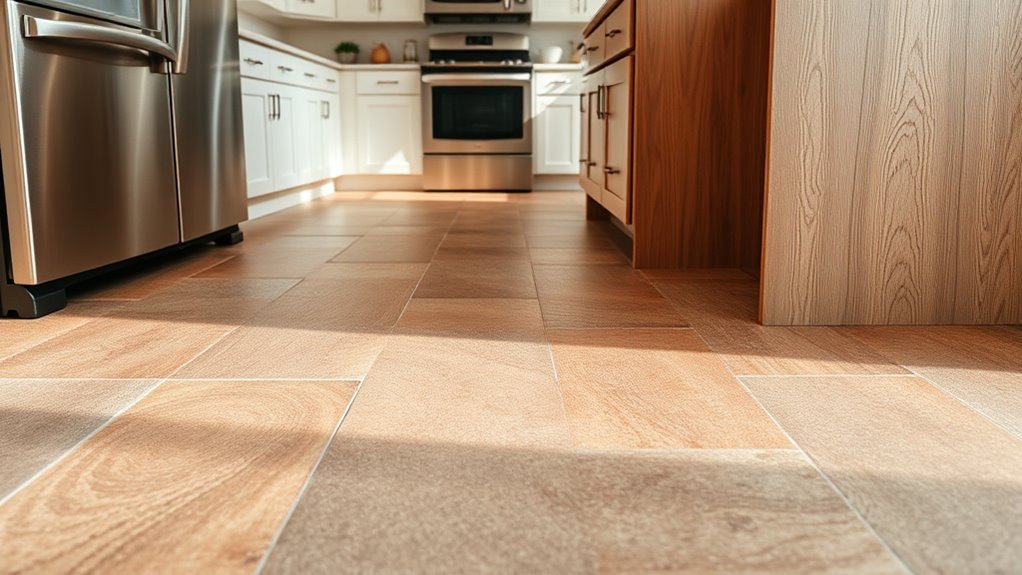
Choosing the right flooring for your kitchen is essential for safety and durability, especially since spills and heavy foot traffic are common. Slip resistant coatings can greatly reduce the risk of slips on smooth surfaces, making your kitchen safer. Installing anti slip rugs in high-traffic or spill-prone areas adds extra grip and comfort underfoot. Look for flooring materials like textured vinyl, cork, or rubber that naturally provide slip resistance. These options are easy to clean and maintain, helping you keep the space safe and hygienic. Combining slip resistant coatings with anti slip rugs creates a layered safety approach, minimizing hazards during busy meal prep times. Prioritizing these features ensures your kitchen remains a secure, functional space for everyone. Additionally, selecting flooring materials with high durability can further enhance safety and longevity in a busy kitchen environment. Incorporating innovative safety features into your flooring choices can also contribute to a more secure cooking area, reducing the risk of accidents. Using non-slip coatings on existing surfaces can provide an extra layer of protection without the need for complete flooring replacement. Moreover, advancements in robotic automation are increasingly being integrated into commercial kitchens to improve operational efficiency and safety.
Durable Non-Slip Choices for Living Rooms and Hallways
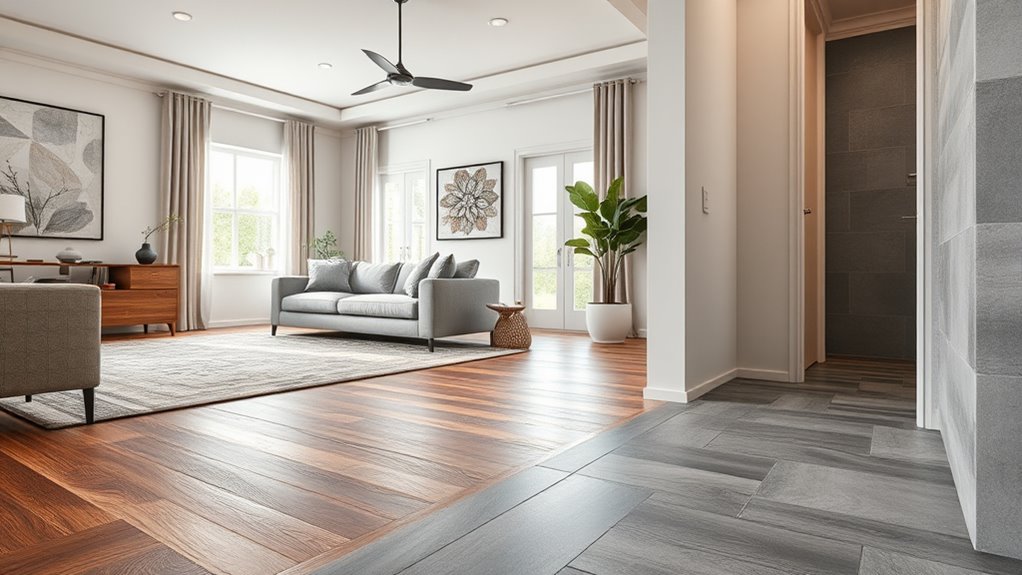
When choosing non-slip flooring for your living rooms and hallways, you want surfaces that resist slips and last over time. Consider the different types of slip-resistant finishes and how durable the materials are for daily wear. Also, think about how easy they are to maintain and keep safe for everyone in your home. Incorporating skincare innovation techniques such as high-quality, textured finishes can help ensure safety and longevity in high-traffic areas.
Slip-Resistant Surface Types
Selecting slip-resistant surfaces for your living rooms and hallways guarantees safety without sacrificing style. You can achieve this with innovative surface coatings that add an extra layer of protection while maintaining aesthetic appeal. These coatings often feature slip resistant textures, which improve traction and reduce the risk of falls. Options like textured vinyl, epoxy coatings, or specially treated carpets create surfaces that are both durable and safe underfoot. Many of these surfaces are designed to be easy to clean and resistant to wear, making them ideal for high-traffic areas. Additionally, using surface preparation techniques ensures the coatings adhere properly and last longer over time. Incorporating non-slip flooring materials can further enhance safety, especially in areas prone to moisture or spills. Understanding the importance of contrast ratio can also help in selecting flooring options that improve visibility and reduce accidents. Recognizing the genetic variation in dog breeds can inspire you to choose pet-friendly flooring options that accommodate your furry friends’ needs. Moreover, selecting materials with high durability guarantees longevity, even in busy households.
Material Durability Factors
Durability plays an essential role in ensuring your non-slip flooring withstands daily wear and tear in living rooms and hallways. When selecting materials, consider slip resistance and material longevity, which directly impact how well your floors perform over time. Durable options like vinyl, laminate, and certain hardwoods offer strong resistance to scratches, dents, and stains, maintaining their slip-resistant properties longer. Look for flooring with high-quality finishes and dense construction to prevent premature wear. The better the material’s longevity, the less you’ll need to replace or repair, saving you money and effort. Additionally, choosing robust construction techniques can further enhance the durability of your flooring. Recognizing the importance of material durability can guide you toward options that provide long-term safety and aesthetic appeal. Keep in mind that a durable, slip-resistant surface not only enhances safety but also preserves the aesthetic appeal of your living spaces for years to come.
Maintenance and Safety
Are you aware that proper maintenance is key to keeping your non-slip flooring safe and long-lasting? Regular cleaning removes dirt and debris that can diminish slip resistance, ensuring your floors stay safe underfoot. Use gentle cleaners suited to your flooring material to preserve both slip resistance and flooring aesthetics. Avoid harsh chemicals that could damage the surface or reduce its grip. Inspect your floors regularly for wear or damage, and address issues promptly to prevent accidents. Maintaining slip resistance is vital, especially in high-traffic areas like living rooms and hallways. Proper maintenance practices can significantly extend the life of your non-slip flooring. By keeping your floors clean and in good condition, you enhance safety while preserving their appearance. Good upkeep ensures your non-slip flooring remains durable and visually appealing for years to come.
Non-Slip Surfaces for Commercial and High-Traffic Areas
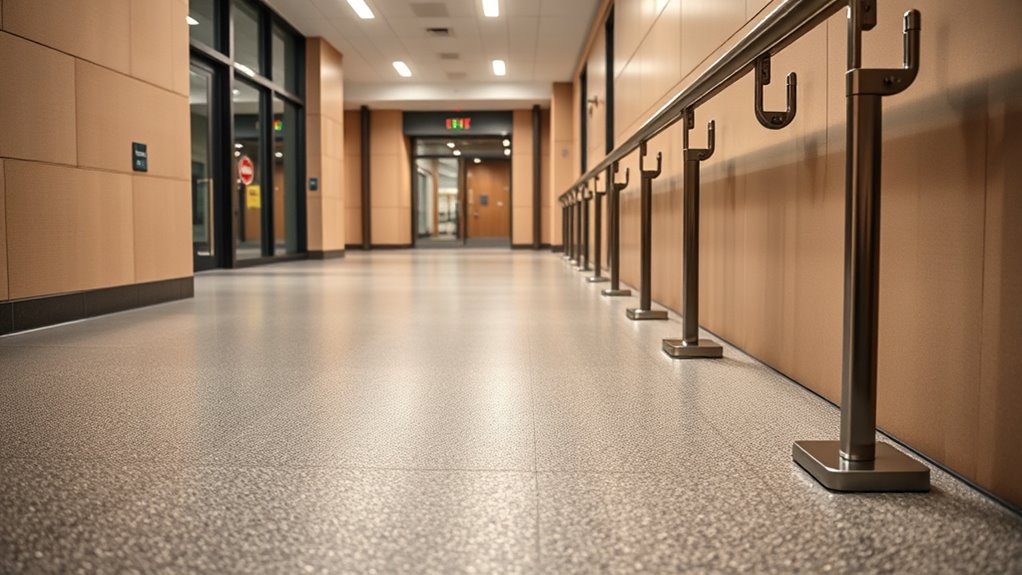
In busy commercial and high-traffic areas, choosing the right non-slip flooring is crucial to guarantee safety and prevent accidents. You want surfaces that provide reliable grip without compromising interior design or aesthetic appeal. Materials like textured vinyl, rubber, and safety-rated tiles are excellent options because they combine durability with slip resistance. These surfaces can be seamlessly integrated into your space’s overall look, enhancing visual appeal while maintaining safety standards. Keep in mind that high-traffic zones demand flooring that withstands constant wear without losing traction. Additionally, selecting flooring with rustic charm can complement farmhouse interior styles while ensuring safety. By selecting non-slip surfaces suited for busy environments, you ensure both safety and style, creating a welcoming space that’s functional and visually appealing for staff and visitors alike.
Best Materials for Outdoor and Patio Safety
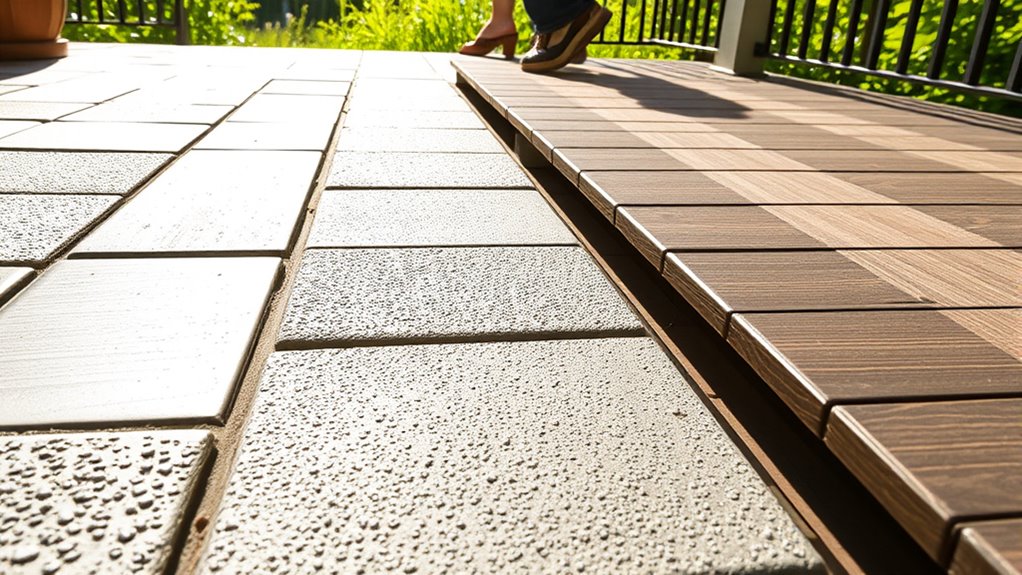
Choosing the right materials for outdoor and patio safety is essential to prevent slips and falls in your outdoor spaces. Durable, textured surfaces like stamped concrete or textured pavers provide good traction, especially when wet. For added grip, consider installing non-slip coatings or sealants on these surfaces. While interior carpet isn’t suitable outdoors, decorative rugs designed for outdoor use can add style without sacrificing safety. Opt for rugs with non-slip backing or use outdoor rug pads to prevent slipping. Rubber tiles or mats are excellent choices for patios, offering both cushioning and slip resistance. Remember, avoiding smooth, polished surfaces reduces fall risk. Prioritize materials that resist moisture and provide traction to keep your outdoor areas safe and inviting year-round.
Tips for Maintaining and Cleaning Non-Slip Flooring

To keep non-slip flooring safe and effective, regular cleaning and maintenance are essential. Use gentle cleaning techniques, like sweeping or vacuuming, to remove dirt and debris that can cause slips. For stains, act quickly with appropriate stain removal methods to prevent permanent damage. Avoid harsh chemicals that might dull the surface or compromise slip resistance. Here’s a quick guide:
| Cleaning Technique | Suitable for | Tips |
|---|---|---|
| Sweeping/Vacuuming | Daily dirt | Prevent buildup |
| Damp Mopping | Routine cleaning | Use mild soap |
| Spot Cleaning | Stains | Blot, don’t scrub |
| Deep Cleaning | Heavy grime | Use non-abrasive cleaners |
Regular maintenance keeps your flooring safe and prolongs its lifespan.
Frequently Asked Questions
How Do I Choose the Best Non-Slip Flooring for Children’S Rooms?
When choosing non-slip flooring for children’s rooms, prioritize child safety by selecting materials with textured surfaces that prevent slips. Look for options that offer durability, since kids can be rough on floors. You should consider soft yet sturdy materials like rubber or vinyl, which absorb impacts and are easy to clean. Ultimately, guarantee the flooring provides a safe, long-lasting environment where your children can play and grow comfortably.
Are Eco-Friendly Non-Slip Flooring Options Available for Residential Use?
You’ll find eco-friendly non-slip flooring options for your home, including recycled options and biodegradable materials. These flooring choices help reduce environmental impact while providing safety. Look for products made from sustainably sourced or recycled materials, and check for labels indicating biodegradability. You can enjoy a safe, slip-resistant surface that’s good for the planet, ensuring your space remains both eco-conscious and secure for everyone.
Which Non-Slip Flooring Materials Are Most Cost-Effective Long-Term?
Imagine your floors as the foundation of a sturdy ship, guiding you safely through daily waves. When choosing non-slip flooring, you’ll want to weigh cost comparison and durability factors. Vinyl often shines as the most cost-effective long-term option, offering resilience without breaking the bank. It’s like a reliable anchor—affordable today and built to last, ensuring your home remains safe and steady through life’s storms.
How Does Indoor Air Quality Impact Non-Slip Flooring Choices?
Indoor air quality affects your flooring choices because some materials can release airborne pollutants, impacting your health. You should consider ventilation requirements to make certain of proper air circulation, especially with non-slip flooring that might trap dust or allergens. By choosing flooring with low VOC emissions and good ventilation, you reduce airborne pollutants, creating a healthier environment and maintaining better indoor air quality over time.
Can Non-Slip Flooring Be Installed Over Existing Surfaces Safely?
Sure, installing non-slip flooring over existing surfaces sounds like a breeze—until you realize surface preparation and installation considerations are your new best friends. You’ll need to make certain the old surface is clean, smooth, and sturdy enough to handle the new layer. Ignoring these steps can turn your project into a slippery slope of issues. So, take your time, prep thoroughly, and you’ll enjoy safe, durable flooring without surprises.
Conclusion
So, now that you know the secret to avoiding slip-and-slide adventures at home, it’s time to pick your perfect non-slip flooring. Whether you’re tackling a bathroom or a busy commercial space, remember: safety doesn’t have to be boring. With the right materials, you can slip-free and still impress your guests. Who knew that choosing the right flooring could turn your space into a fortress of safety—and maybe even make your neighbors jealous?
